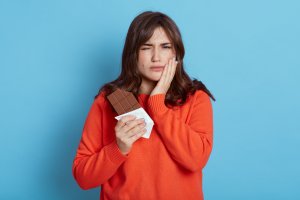You’ve made it through your surgery and now you’re starting to get hungry. That’s probably got you thinking: when can I eat? And, how long after tooth extraction can I eat on that side?
If you’ve had a tooth extraction on just one side of your mouth, that certainly makes it easier to eat foods, but you still need to be careful.
Keep reading below to learn more about:
- How soon you can eat after tooth extractions
- When you can eat on that side of your mouth
- What to do if you’ve had teeth removed on both sides of your mouth
- If eating will dislodge the blood clot
- Which foods you should eat and which you should avoid
In This Article
How soon can I eat after tooth extraction?
Immediately after, and for the first 24 to 48 hours following your tooth extraction, you will want to stick with liquids or soft foods. Basically, don’t eat anything that requires you to chew a lot. You should also avoid anything that could get stuck in the extraction site and dislodge the blood clot.
You’ve just made it through your tooth surgery and don’t want to jeopardize your healing process by chewing food that could cause bleeding or pain.
As you start the healing process, you will be able to begin eating other foods that are semi-soft, such as scrambled eggs or mashed potatoes.
Once you are comfortable with that, you can then get back to your normal diet. Before you know it, you will be completely healed!
How long do I have to wait before I can eat on the side of a tooth extraction?
To protect your extraction site and promote optimal healing of your empty socket, you should try to only eat on the opposite side of your mouth from where the tooth was extracted.

After you have started to heal, you can begin to eat on the side of the mouth where your tooth was pulled.
What do I do if I’ve had teeth removed on both sides?
If you’ve had teeth removed on both sides, you’re probably experiencing more pain. Switching ice packs from side to side can help with the swelling and the pain.
With teeth extracted on both sides, you should stick to soft foods. However, make sure you do eat. It’s important that you don’t skip meals because keeping up with your health and nutrition will help you heal properly.
Will eating dislodge my blood clot and cause dry socket after tooth extraction?

Eating certain foods after your surgery could definitely dislodge the blood clot that has formed at the extraction site, causing dry socket to develop. This will cause it to take longer to heal.
In general, you want to avoid any kind of crunchy or hard foods because they could easily get lodged in the extraction site or cause bleeding.
The other thing to avoid is drinking out of a straw. If you’re thinking you will just stick to a liquid diet for a little while to be safe, make sure that it doesn’t involve a straw. The sucking motion from using a straw can dislodge the clot.
Your surgeon will likely recommend that you try gently rinsing your mouth with warm salt water a couple of times a day. Taking care of the site can help prevent severe infection and help the wound to heal quicker.
How to Eat After Tooth Extraction Surgery: Foods To Avoid
As we mentioned above, you’ll want to stick with soft food after your tooth extraction, especially for the first 24 hours. By enjoying softer items, you can avoid chewing.
Some of the best soft food to enjoy during the first 24 hours include:
- Yogurt
- Applesauce
- Smoothies
- Jell-o
- Pudding
- Soups (not hot)
- Ice cream
After the initial 24 hours, you can move on to more semi-soft foods that require little chewing such as:
- Scrambled eggs
- Mashed potatoes
- Pancakes
- Oatmeal
Here are some examples of food you should avoid:
- Hard foods
- Spicy foods
- Seeds or grains
- Popcorn, chips, or nuts
- Cookies
In addition to the above-listed foods to stay away from, you should also avoid alcohol and cigarettes.
For your health, it’s recommended to refrain from alcohol use for at least 24 hours after your surgery and to refrain from smoking for a couple of days because it creates that sucking motion that can dislodge the clot.
Make sure you follow your dentist’s instructions and advice for proper healing of the wound post tooth extraction.
Conclusion
In this guide, we’ve covered everything you might want to know about how long you should wait before you eat on the side of your mouth where you had a tooth extracted.
While it’s best to try and eat on the opposite side, that’s not always possible, especially if you had a procedure where teeth were pulled on both sides. In that case, you may want to stick with soft foods rather than solid foods for a little while. This will help the wound to heal faster.
Follow guidelines from your dentist post-surgery, including any treatment plan he or she has recommended. By taking care of the site and keeping it clean, you can avoid the risk of pain and infection.
If you have any questions about the health of the extraction site, do call your oral surgeon.




